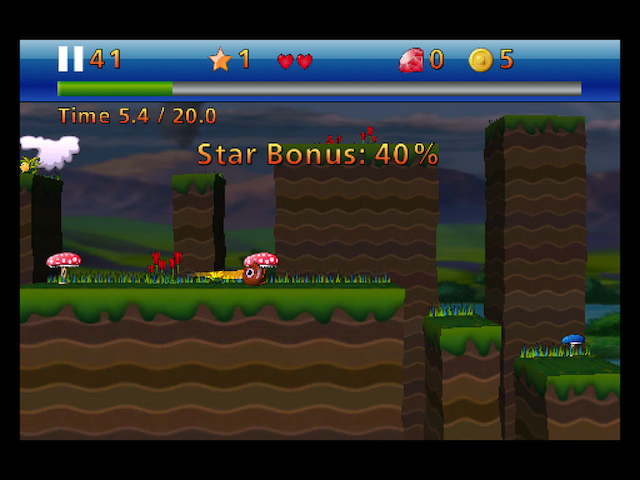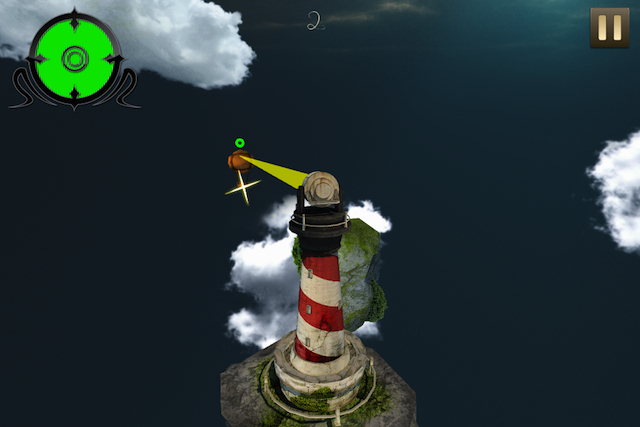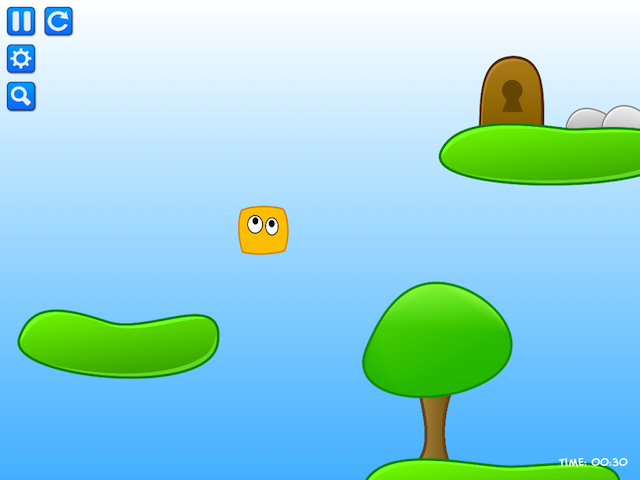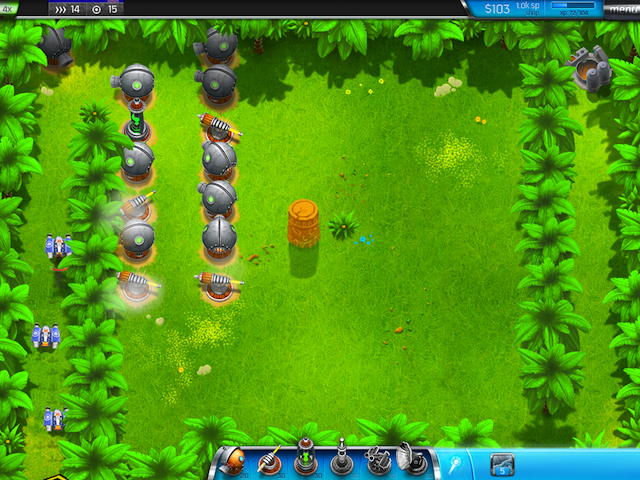If you’ve spent a full week at work then the chances are good that you’ve already played through most of the games that we suggested last week and are ready for some more iOS goodness to sink your teeth into.
Before we start though, let me just remind you that Ghost Trick from Capcom was released onto the iOS App Store last week and I can’t recommend it enough, go and start it downloading (it is free for the first couple of chapters) while I tell you about some more cool games that could be coming your way, then after that you can read my review of the Nintendo DS version of the game.
First we’ve got Jump N’ Roll, a physics based platforming game with a slight RPG element within the gameplay. Light Guardian is a quickfire game that tasks the players with keeping airships away from lots of randomly floating rocks. Qube is another physics based platformer, this time with an interesting control mechanic that is rather difficult to explain but easy to pick up. Last, but not least, there’s Spice Invaders. Yes, it sounds like something you’ve played before, no, it most certainly isn’t; it’s a gorgeous looking tower defence game that may suck away all of your waking hours if you let it.
That’s it for this week but I’m sure that it’s more than enough, check back next week when we’ll have four more games for you perusal.
Get downloading and get gaming!
Titles are available on iPhone and iPad unless specifically stated otherwise. If you like what you read, click the small black “App Store” button to load iTunes up and purchase the title!
![]() JUMP N’ ROLL:
JUMP N’ ROLL:
There isn’t a shortage of platform games on the iOS App Store, some of them being quite good (Storm in a Teacup instantly comes to mind) but the vast majority of them are just cheap rip-offs of other, more popular titles and have clearly been made as an attempt to grab unsuspecting mobile gamer’s cash. When I first looked at Jump N’ Roll I wasn’t sure what I should be thinking, the visuals made it look like one of those aforementioned “cheap rip-offs” but the gameplay managed to hold its own, being surprisingly enjoyable.
The gameplay in Jump N’ Roll is pure platform based fun, the player is given the task of jumping from platform to platform collecting as many valuable items as they can get their hands on. The difficulty in the game comes from the fact that the ball that the player is in control of never stops rolling, adding a sense of urgency to proceedings as you’ll have to figure out what move you’re going to make well before you get there. There are two layers to the game world and the player can swap between the two by using mushrooms that are dotted around the world to bounce on. The back layer being much more difficult to traverse but reaping the greater rewards.

The ball that the player is in control of has the ability to double jump, but as with most things that could potentially make life easier, the use of this feature is limited. As long as the player has some energy left in the bar at the top of the screen they’ll be able to double jump, empty this bar though and you’re up the proverbial creek without your trusty paddle. There are many areas of the game where being able to double jump is a requirement, so the player will have to ration its use. There’s no way of telling if there’s an area where you’re going to need it lying just around the next corner.
The controls of Jump N’ Roll are quite simple, all players have to do is tap the left hand side of the screen to jump (tapping it again to double jump), and tap the right hand side to attack. The attacking mechanic only really comes into play later on in certain levels and it’s extremely easy to forget that the character even has this ability, especially since the buttons for jump disappear after so long in order to show the player more of the screen; a blessing and a curse. Despite the buttons disappearing, which can make life a little difficult for people that don’t play video games often enough to be able to play a game without constantly looking at the buttons, the controls are relatively easy to pick up and get to grips with. You’ll be attacking, jump and double jumping in no time!
There’s a lot of gameplay available in Jump N’ Roll in the form of quests and if you find yourself enjoying the game then you could be playing it for a long while. However, the mechanics of the game can get a little repetitive after only a short amount of time meaning that it’s probably only a game that people will play for five or ten minutes at a time. Playing it for extended periods would be difficult unless you fall in love with it within the first five minutes. The visuals could have done with a little bit more work in order to make the game more appealing to a wider range of people, at the moment it’s a mediocre looking game with gameplay that can be entertaining at times. Worth a try at least but nothing particularly special. 

![]() LIGHT GUARDIAN:
LIGHT GUARDIAN:
When it comes to the point where you’re giving your application a name, something that you’ve worked on for – sometimes – several months, I’ve always said that it’s better to go with a name that informs the potential player as to what exactly the game is but while also giving a little bit of intrigue, something that will surprise them when they do open up the game and see exactly what you’ve got waiting for them in there. Light Guardian is exactly that, the name, as well as the icon for it, gives you an indication as to what you’re going to be doing in the game (controlling a lighthouse) but there’s absolutely no indication that you’re going to be controlling a sky lighthouse, tasked with helping airships to avoid randomly hovering lumps of rock. Intrigue indeed.
The gameplay revolves around aiming the beam of light being emitted by the lighthouse at a little target on the top of the airships, doing so will cause them to disappear and avoid hitting the rocks. Once you’ve done this for one airship, look for another and do the same all over again; rinse and repeat until the level ends. The difficulty lies in the fact that because this is a sky lighthouse it’s operating on three axis’ instead of the two that a normal lighthouse does. In Light Guardian the airships could be anywhere around you but could also be above you or beneath you, making spotting them a whole lot harder. You do get a little indicator at the edge of the screen to inform you that an airship is somewhere in the vicinity, but while it tells you where they are, it doesn’t give you a lot of information about how far away they are, meaning you’re going to have to at least have a quick look in order to prioritise things.

The controls for Light Guardian are relatively simple once you’ve figured out what you’re supposed to do. It’s easy to realise that you’re supposed to move the head of the lighthouse in order to point the beam at the different airships, that’s more or less assumed (or at least it should be), what is a little bit more difficult to grasp is the fact that the player is supposed to tap an area underneath the head of the lighthouse, which focuses the beam of light somewhat, and is the only way to play the game. Just pointing the light without focusing it at the airships will do nothing and is a definite way to fail the game and frustrate the player. I play a lot of games, for work and for pleasure, and it took me a few attempts and a quick look at the help screen in order to figure out what I was supposed to do.
The major downside about Light Guardian, is that I simply couldn’t get the game to work on anything other than my wife’s iPhone 4S. When I tried to install both versions of the game (there’s a “Lite” version as well as the main version) on my iPhone 3G or my iPad I couldn’t get past the main menu. It looked as if the resolution of the game is set for the retina display and won’t shrink down to fit on the non-retina displays. Terrible lack of foresight from the developer and – in all honesty – I wouldn’t feel comfortable recommending this game to anyone until they fix this issue. That being said, for those of you lucky to have an iPhone 4 or above, it’s not a bad game. Worth a shot at least. 

![]() QUBE:
QUBE:
More and more games that grace the iOS App Store have been developed and produced by teams of people, all the way from concept through to the final deployment there have been many hands involved. With that increasingly becoming the norm on the App Store it’s nice to see a game being released that doesn’t follow the same rules as all the others. A game that breaks the mould and is developed by a single mind, a single vision, a sole developer. That developer is Klaus Silveira and the game is Qube, a quirky little platformer with an interesting control method. Flicking the little “Qube” across the screen as if you’re flicking an elastic band.
The main gameplay element of Qube is to get the main character to the exit in a series of levels with an ever increasing difficulty. There’s no hand holding in Qube, if you miscalculate the distance of the jump and pull back on the little yellow box just a little too far, you’ll send him flying to the other edge of the screen and you’ll have to start the whole thing all over again. Yes, it’s frustrating but that’s why we play games like this, because when we finally do complete a level we get a sense of satisfaction that’s almost second to none. Qube isn’t as good as something such as Super Meat Boy but it’s certainly one of the more difficult games available; especially if you don’t have a basic knowledge of trajectory and gravitational cause and effect. What goes up must come down after all.

The controls in Qube task the player with grabbing the main character and pulling back. The distance that you pull will determine how far the Qube will fly and the direction will be the exact opposite of the direction that you’re pulling. Think of the control scheme of Angry Birds and you’re about there. It looks a little bit more complicated than that on first glance but it’s exactly the same once you get down to the base mechanics. They’re easy enough to get used to once you’ve wrapped your head around what is being asked of you, just don’t expect to master it any time soon. You’ll often give it way too much power, overshooting the platform you’re meant to be landing on and restarting levels over and over again. If you’re not ready for that, then you’re not ready for Qube.
As you would expect from a game that’s being developed by a single person – and a person that has obvious programming leanings instead of artistic ones – Qube is a little lacking in the visual department. Most of the game comprises of simple shapes and blocks of colour. I couldn’t help thinking how much more I could have potentially enjoyed this game if an artist that was capable of something half decent would have been hired for the project. It doesn’t affect the game too much but it’s one of those things that people are sure to notice from the moment they start the game.
Qube is certainly a game worth playing, it’s nothing special in the gameplay department, or the artistic one for that matter, but there’s a kind of charm embedded within it that you can only get from a piece of software that’s been developed by entirely focussed minds. In this case, a single mind. For that reason alone it’s worth a download, and at least 10-15 minutes of your time. Who knows, if enough people download it, maybe the next game will be the next iOS benchmark game. You never know. 

![]() SPICE INVADERS:
SPICE INVADERS:
If you’re anything like me then you’ll look at the name Spice Invaders and assume that it’s a cheap knock off of Space Invaders and move right along. We’ve all played that game, why do we need to play a cheap version of it? This however, is where the old proverb of never judging a book by its cover comes into play, as just because it’s called Spice Invaders doesn’t mean it’s anything like you instantly assume it is. Spice Invaders is a gorgeous looking Tower Defence game from the guys over at Chillingo and the developer On-5, so from the very first moment you’re going to be shocked at what you’re experiencing; and it only gets more and more surprising from that moment on.
Just as with any Tower Defence game you may have played before, the gameplay in Spice Invader tasks the player with destroying the seemingly endless streams of enemies before they reach your base. In order to do this the player must place towers, or both offensive and defensive purposes, in strategic locations around the map. When an enemy comes into the range of these towers they will activate, performing whatever activity they were built for. The difference in Spice Invaders, at least at this very basic game mechanic level, is the fact that you’re playing as the invading army this time. You’re the Spice Pirates that are trying to take over the Earth in order to get at that glorious Spice that those pesky Earthlings have been keeping for themselves; it’s time to take it all!

Most of your time will be spent in the main game mode, slaughtering the sometimes insane amount of enemies that are coming your way, but the more cautious among you will also spend a lot of your time in the Spice Market. This is where you take the Spice that you attained performing your murderous actions in the main game and spend it on upgrading the many aspects of your invading war machine, including the weapons. This is the only area of the game where real money is involved, the game itself is free, so it’s the least you could do to buy a shipment of Spice to bolster your supplies in order to grease the wheels of your invasion.
The controls in Spice Invaders are easy to get used to too, simply tap a piece of equipment from the bar at the bottom of the screen and then tap where in the battlefield you want to place it. As with any other Tower Defence game the key to success is to lead the enemy to where you want them to go by using your weapons to block any other way they may attempt to attack via. The simplistic controls allow for the kind of quick thinking often required to pull off tactics like this and it’s very welcome. Almost anybody will be able to pick up and play Spice Invaders with relative ease with only the people who never play game having problems; but even then, a few little skirmishes and they’ll be fluent in Spice Pirate and leading enemies to their death like a pro.
If you haven’t already started downloading Spice Invaders on the basis of what I’ve already said then you’re a fool. You could have had it downloaded and ready for this point, the bit where I tell you that it’s one of the most fun, polished and addictive games on the App Store. Not to mention the fact that it’s free. The visuals are gorgeous and the introduction alone is done to a standard that sometimes isn’t seen on console games. You’ve got nothing to lose by downloading Spice Invaders (except maybe lots of time) but you’ve got the potential of being able to carry around an excellent game that everybody should be playing, and you’ll have gotten in on the ground floor! 






